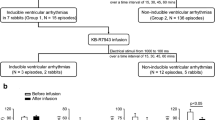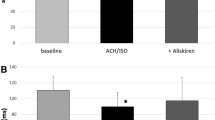Abstract
Aim
To investigate ventricular conduction and refractoriness before and after application of rotigaptide, an enhancer of gap junctional conductance, to explanted hearts of patients with heart failure (HF).
Methods and results
In six explanted perfused hearts of patients with end-stage HF, activation/repolarization mapping was performed and refractory periods (RPs) and activation recovery intervals (ARIs) were measured before and after application of 50 nM rotigaptide. Rotigaptide caused a decrease of RP from 476 ± 36 to 453 ± 31 ms (P < 0.05), but did not change ARI-dispersion. During premature activation along the fibers rotigaptide decreased the minimal activation time (ATmin) and maximal activation time (ATmax) significantly from 35 ± 12 to 24 ± 9 and from 97 ± 38 to 43 ± 7 ms, respectively. Rotigaptide did not change ATmin and ATmax during activation perpendicular to the fiber direction. After application of rotigaptide conduction curves normalized in five/six recordings when activation was parallel, but destabilized in three/six hearts when activation was perpendicular to fiber direction. The destabilization was associated with local conduction delays rather than with facilitation of conduction.
Conclusion
Rotigaptide applied to hearts of patients with end-stage HF shortened RPs normalized conduction curves and increased conduction parallel to fiber direction. However, in 50% of the hearts local slowing of conduction with destabilization of conduction (curves) occurs at sites close to the stimulation site, when activation is perpendicular to fiber direction.








Similar content being viewed by others
References
Ai X, Pogwizd SM (2005) Connexin 43 downregulation and dephosphorylation in nonischemic heart failure is associated with enhanced colocalized protein phosphatase type 2A. Circ Res 96:54–63
Akar FG, Spragg DD, Tunin RS, Kass DA, Tomaselli GF (2004) Mechanisms underlying conduction slowing and arrhythmogenesis in nonischemic dilated cardiomyopathy. Circ Res 95:717–725
Akar FG, Nass RD, Hahn S, Cingolani E, Shah M, Hesketh GG, DiSilvestre D, Tunin RS, Kass DA, Tomaselli GF (2007) Dynamic changes in conduction velocity and gap junction properties during development of pacing-induced heart failure. Am J Physiol Heart Circ Physiol 293:H1223–H1230
Conrath CE, Wilders R, Coronel R, De Bakker JMT, Taggart P, de Groot JR, Opthof T (2004) Intercellular coupling through gap junctions masks M cells in the human heart. Cardiovasc Res 62:407–414
Coronel R, Casini S, Koopmann TT, Wilms-Schopman FJ, Verkerk AO, de Groot JR, Bhuiyan Z, Bezzina C, Veldkamp MW, Linnenbank AC, van der Wal AC, Tan HL, Brugada P, Wilde AAM, de Bakker JM (2005) Right ventricular fibrosis and conduction delay in a patient with clinical signs of Brugada syndrome. A combined electrophysiological, genetic, histopathological and computational study. Circulation 112:2769–2777
Coronel R, de Bakker JM, Wilms-Schopman FJ, Opthof T, Linnenbank AC, Belterman CN, Janse MJ (2006) Monophasic action potentials and activation recovery intervals as measures of ventricular action potential duration: experimental evidence to resolve some controversies. Heart Rhythm 3:1043–1050
de Bakker JM, van Capelle FJ, Janse MJ, van Hemel NM, Hauer RN, Defauw JJ, Vermeulen FE, Bakker de Wekker PF (1991) Macroreentry in the infarcted human heart: the mechanism of ventricular tachycardias with a “focal” activation pattern. J Am Coll Cardiol 18:1005–1014
Delmar M, Michaels DC, Johnson T, Jalife J (1987) Effects of increasing intercellular resistance on transverse and longitudinal propagation in sheep epicardial muscle. Circ Res 60:780–785
Dhein S, Hammerath B (2001) Aspects of the intercellular communication in aged hearts: effects of the gap junction uncoupler palmitoleic acid. Naunyn Schmiedebergs Arch Pharmacol 364:397–408
Dhein S, Kruseman K, Schaefer T (1999) Effects of the gap junction uncoupler palmitoleic acid on the activation and repolarization wavefronts in isolated rabbit hearts. Br J Pharmacol 128:1375–1384
Dhein S, Larsen BD, Petersen JS, Mohr FW (2003) Effects of the new antiarrhythmic peptide ZP123 on epicardial activation and repolarization pattern. Cell Commun Adhes 10:371–378
Eloff BC, Gilat E, Wan X, Rosenbaum DS (2003) Pharmacological modulation of cardiac gap junctions to enhance cardiac conduction: evidence supporting a novel target for antiarrhythmic therapy. Circulation 108:3157–3163
Fast VG, Kléber AG (1995) Block of impulse propagation at an abrupt tissue expansion: evaluation of the critical strand diameter in 2- and 3-dimensional computer models. Cardiovasc Res 30:449–459
Fast VG, Kléber AG (1995) Cardiac tissue geometry as a determinant of unidirectional conduction block: assessment of microscopic excitation spread by optical mapping in patterned cell cultures and in a computer model. Cardiovasc Res 29:697–707
Fischer P, Hilfiker-Kleiner D (2007) Survival pathways in hypertrophy and heart failure: the gp130-STAT3 axis. Basic Res Cardiol 102:393–411
Guerra JM, Everett TH IV, Lee KW, Wilson E, Olgin JE (2006) Effects of the gap junction modifier rotigaptide (ZP123) on atrial conduction and vulnerability to atrial fibrillation. Circulation 114:110–118
Haugan K, Olsen KB, Hartvig L, Petersen JS, Holstein-Rathlou NH, Hennan JK, Nielsen MS (2005) The antiarrhythmic peptide analog ZP123 prevents atrial conduction slowing during metabolic stress. J Cardiovasc Electrophysiol 16:537–545
Kawara T, Derksen R, de Groot JR, Coronel R, Tasseron S, Linnenbank AC, Hauer RN, Kirkels H, Janse MJ, de Bakker JM (2001) Activation delay after premature stimulation in chronically diseased human myocardium relates to the architecture of interstitial fibrosis. Circulation 104:3069–3075
Kjølbye AL, Knudsen CB, Jepsen T, Larsen BD, Petersen JS (2003) Pharmacological characterization of the new stable antiarrhythmic peptide analog Ac-d-Tyr-d-Pro-d-Hyp-Gly-d-Ala-Gly-NH2 (ZP123): in vivo and in vitro studies. J Pharmacol Exp Ther 306:1191–1199
Kleber AG, Janse MJ, Wilms-Schopman FJG, Wilde AAM, Coronel R (1986) Changes in conduction velocity during acute ischemia in ventricular myocardial isolated porcine heart. Circulation 73:189–198
Kwak BR, Jongsma HJ (1996) Regulation of cardiac gap junction channel permeability and conductance by several phosphorylating conditions. Mol Cell Biochem 157:93–99
Lammers WJEP, Schalij MJ, Kirchhof CJHJ, Allessie MA (1990) Quantification of spatial inhomogeneity in conduction and initiation of reentrant atrial arrhythmias. Am J Physiol 259:H1254–H1263
Lesh MD, Pring M, Spear JF (1989) Cellular uncoupling can unmask dispersion of action potential duration in ventricular myocardium. A computer modeling study. Circ Res 65:1426–1440
Mines GR (1914) On circulating excitation in heart muscles and their possible relation to tachycardia and fibrillation. Trans R Soc Can IV:43–52
Muller A, Schaefer T, Linke W, Tudyka T, Gottwald M, Klaus W, Dhein S (1997) Actions of the antiarrhythmic peptide AAP10 on intercellular coupling. Naunyn Schmiedebergs Arch Pharmacol 356:76–82
Peters NS, Coromilas J, Severs NJ, Wit AL (1997) Disturbed connexin43 gap junction distribution correlates with the location of reentrant circuits in the epicardial border zone of healing canine infarcts that cause ventricular tachycardia. Circulation 95:988–996
Potse M, Linnenbank AC, Grimbergen CA (2002) Software design for analysis of multichannel intracardial and body surface electrocardiograms. Comput Methods Programs Biomed 69:225–236
Querejeta R, Varo N, Lopez B, Larman M, Artinano E, Etayo JC, Martinez Ubago JL, Gutierrez-Stampa M, Emparanza JI, Gil MJ, Monreal I, Mindan JP, Diez J (2000) Serum carboxy-terminal propeptide of procollagen type I is a marker of myocardial fibrosis in hypertensive heart disease. Circulation 101:1729–1735
Rohr S, Kucera JP, Fast VG, Kléber AG (1997) Paradoxical improvement of impulse conduction in cardiac tissue by partial cellular uncoupling. Science 275:841–844
Sáez JC, Nairn AC, Czernik AJ, Fishman GI, Spray DC, Hertzberg EL (1997) Phosphorylation of connexin 43 and the regulation of neonatal rat cardiac myocyte gap junctions. J Mol Cell Cardiol 29:2131–2145
Schulz R, Boengler K, Totzeck A, Luo Y, Garcia-Dorado D, Heusch G (2007) Connexin 43 in ischemic pre- and postconditioning. Heart Fail Rev 12:261–266
Shaw RM, Rudy Y (1997) Ionic mechanisms of propagation in cardiac tissue. Roles of the sodium and L-type calcium currents during reduced excitability and decreased gap junction coupling. Circ Res 81:727–741
Spach MS, Heidlage JF, Dolber PC, Barr RC (2008) Mechanism of origin of conduction disturbances in aging human atrial bundles: experimental and model study. Heart Rhythm 4:175–185
Wang Y, Rudy Y (2000) Action potential propagation in inhomogeneous cardiac tissue: safety factor considerations and ionic mechanism. Am J Physiol Heart Circ Physiol 278:H1019–H1029
Weng S, Lauven M, Schaefer T, Polontchouk L, Grover R, Dhein S (2002) Pharmacological modification of gap junction coupling by an antiarrhythmic peptide via protein kinase C activation. FASEB J 16:1114–1116
Wiegerinck RF, van Veen AA, Belterman CN, Schumacher CA, Noorman M, de Bakker JM, Coronel R (2008) Transmural dispersion of refractoriness and conduction velocity is associated with heterogeneously reduced connexin 43 in a rabbit model of heart failure. Heart Rhythm 5:1178–1185
Wilders R, Wagner MB, Golod DA, Kumar R, Wang Y-G, Goolsby WN, Joyner RW, Jongsma HJ (2000) Effects of anisotropy on the development of cardiac arrhythmias associated with focal activity. Pflügers Arch Eur J Physiol 441:301–312
Xing D, Kjølbye AL, Nielsen MS, Petersen JS, Harlow KW, Holstein-Rathlou NH, Martins JB (2003) ZP123 increases gap junctional conductance and prevents reentrant ventricular tachycardia during myocardial ischemia in open chest dogs. J Cardiovasc Electrophysiol 14:510–520
Acknowledgments
The authors gratefully acknowledge Zealand Pharma for providing us with rotigaptide for this study and Dr. Anne Louise Kjølbye for her critical comments. We thank Dr. M. G. Hoogendijk and S. C van Amersfoorth for assistance with the histological sections.
Author information
Authors and Affiliations
Corresponding author
Additional information
Returned for 1. Revision: 14 July 2008 1. Revision received: 26 August 2008
Returned for 2. Revision: 19 September 2008 2. Revision received: 31 October 2008
Returned for 3. Revision: 17 November 2008 3. Revision received: 18 November 2008
Rights and permissions
About this article
Cite this article
Wiegerinck, R.F., de Bakker, J.M.T., Opthof, T. et al. The effect of enhanced gap junctional conductance on ventricular conduction in explanted hearts from patients with heart failure. Basic Res Cardiol 104, 321–332 (2009). https://doi.org/10.1007/s00395-008-0771-7
Received:
Accepted:
Published:
Issue Date:
DOI: https://doi.org/10.1007/s00395-008-0771-7




